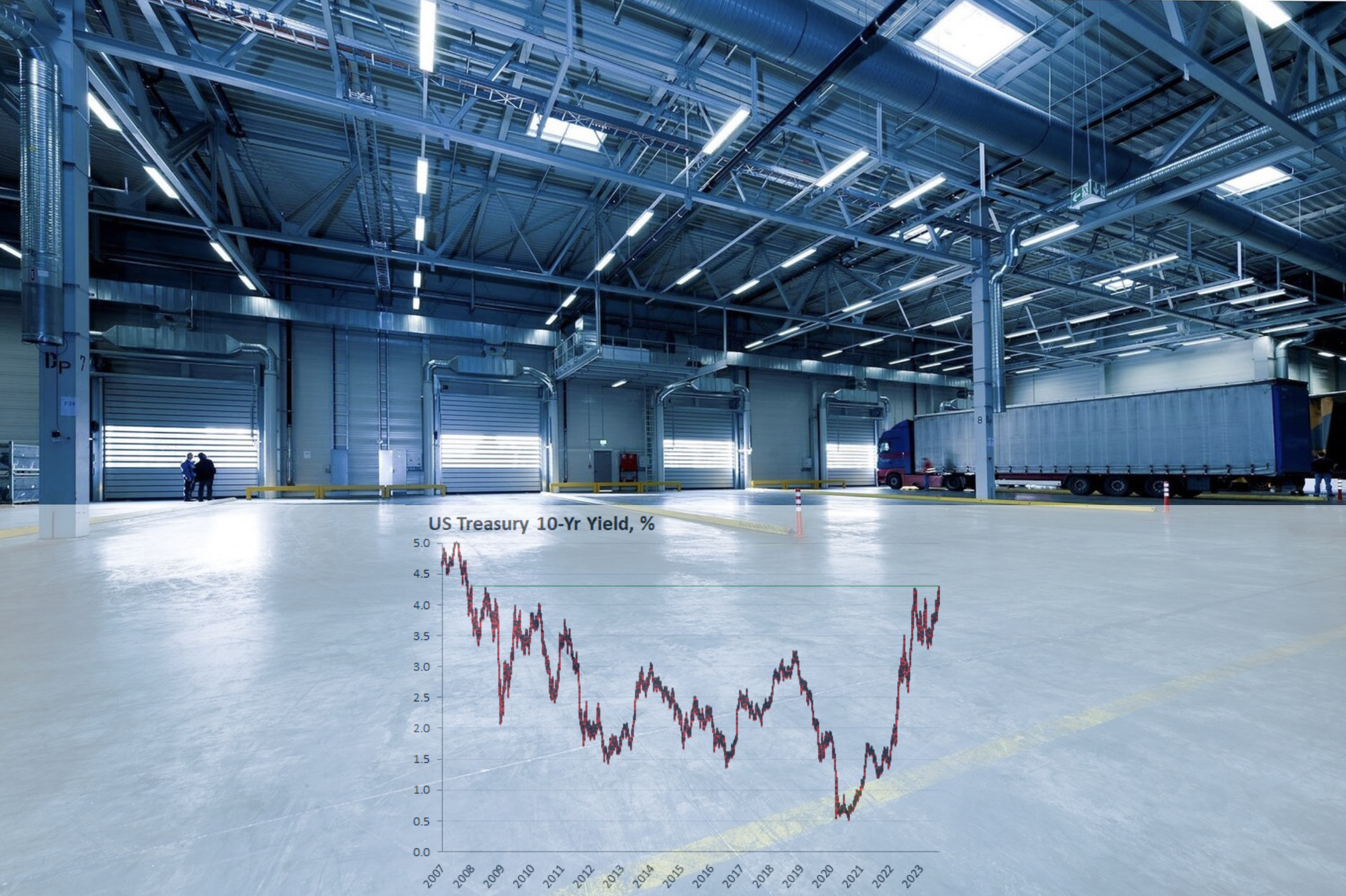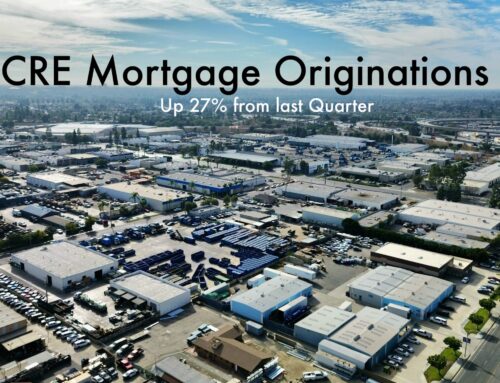When the cost of debt is so high, the return becomes lower than what the 10-year actually pays.
The 10-year US Treasury is currently at a level not seen since June 2007 – 4.79% after the Oct. 6 trading day and it was at 4.66% after trading on Oct. 10. Commercial real estate professionals – like those on Wall Street – are taking notice.
Jeff Wilcox, Principal, Gantry, noted that the historic shift in Treasury levels is putting extreme pressure on cap rates and investor return demands. “Mid- and long-term borrowing rates have increased over 400 basis points in 18 months. The rise in rates has pushed refinance proceeds for all asset classes down by 20% to 25%.”
Wilcox said that all asset classes are feeling the squeeze in proceeds. “Borrowers with maturing debt are most likely looking at cash neutral or cash infusion refinances in order to shoulder the higher rates,” he said. “If rates hold at these levels, CRE values will decrease over the next 12 months as cap rates respond and financing capital is hamstrung by debt service constraints, lowering available proceeds.”
David Fletcher, Excelsa Properties Managing Director and Head of Acquisitions, tells GlobeSt.com that at 4.79%, interest rates remain low but well above the levels used to price assets during the last decade.“This has caused lower multifamily trading volume, assets to price at 2019 and 2020 levels, and ongoing price declines. The forward 10-year treasury curve suggests capital costs will increase during planned hold periods of three to five years. In this context, current prices are not cheap enough. Tangible support for improved liquidity, greater revenues, or lower capital costs will support a rebound in multifamily prices.”
Joseph Rubin, Senior Advisor at EisnerAmper, tells GlobeSt.com that the push of the 10-year Treasury rate toward 5% is solidifying the “higher-for-longer” scenario. “There appears to be no denying that we are returning to the historical average for commercial and multifamily mortgage rates,” Rubin said. “While a painful situation for borrowers with maturing loans, real estate owners/investors achieved appropriate risk-adjusted returns in higher rate environments prior to the Global Financial Crisis. Capital will flow again, but getting to that new normal is going to be a bumpy road.”
Transaction Volume Declining
Tomas Sulichin, President of the Commercial Division at RelatedISG Realty, said the 10-year Treasury is an entire point higher than what it was a year ago.
“This usually means that businesses, investments, and loans are going to become more expensive,” he tells GlobeSt.com. “There are two ways that this negatively impacts the CRE market:
With the cost of debt continuing to increase, CRE is perceived as heightened leverage transactions. When the treasury rate is up and interest rates follow, investors will see a lower return on their money. When there is a lower return, it is less attractive to invest.
He said when the cost of debt is so high, “the return becomes lower than what the 10-year treasury actually pays. In this instance, why buy real estate when you can put money in a 10-year note and get more money than you would by investing in real estate?”
Sulichin said the CRE market in South Florida is seeing a significant slowdown in transaction volume with Miami-Dade County experiencing a 10-year low.
“Despite this, the smarter investment is still in investing in CRE, looking historically at markets like Florida, where the real estate will appreciate and outpace what the treasury note pays,” according to Sulichin.
Likewise, Nick Ganey and Tommy Szarzas, co-founders of Tampa-based Boutique National, tell GlobeSt.com that the short-term effects of the 10-year treasury rise has caused a reduction in transactions in many market sectors throughout the US.
“Some product types have been more resilient than others,” they said. “Retail sector-specific, with a historic lack of supply, rents have continued to rise, even with uncertainty in the market.”
Mortgages Coming Due
Jerry Ruiz, a partner in Frost Brown Todd’s Los Angeles office, tells GlobeSt.com, “For owner-occupied commercial real estate with 5- or 7-year mortgages coming due in the short-term, the impact of the increase in the 10-year treasury rate will similarly cause downward pressure on valuation as owners look to refinance.
“Fortunately, lenders have more flexibility and tools to accommodate this refinancing, including re-amortizing the loans or increasing the loan-to-value percentages, other things such as credit quality being equal. Unlikely, however, would be any ‘cash out’ refinancing in this environment.” Shivan Perera, senior vice president of AVANA Companies, tells GlobeSt.com that when the 10-year Treasury goes up, mortgage rates typically follow suit and become more expensive.
“Commercial real estate investors often use loans to purchase properties,” Perera said.
“Higher interest rates mean higher borrowing costs, which can reduce the amount of money people are willing to pay for commercial properties. Fewer transactions, less cash flow per asset, and more inventory hitting the market are all potential factors in asset price compression.
The 10-year Treasury is also seen as a measure of investor confidence. Prices drop when confidence is high, which causes investment yields to rise. This is because investors feel they can find higher-returning investments elsewhere and do not feel the need to play it safe. At 4.78%, this might signal that there is turmoil ahead.”
This is Not ‘Day Trading’
Shlomo Chopp, managing principal at Terra Strategies, tells GlobeSt.com that interest rates have tightened after years of easy money.
In the past, Chopp said the Fed may have chosen in specific circumstances to directly influence treasuries, (most recently during COVID when the market seized up) but its primary method of tightening or easing revolves around the federal funds rate, which then has a ripple effect on other lending rates including treasuries.
“For several years, I’ve been concerned that many real estate investors have been treating real estate as if it were day trading,” Chopp said.
“For instance, considering retail as obsolete due to challenges stemming from an often-unprofitable model such as e-commerce is shortsighted. The typical real estate investment spans 5 to 10 years, and as a real estate investor, you would need the stability of your logistics tenants to survive that term, and then also not be stuck refinancing into in a low-demand market.
“In recent years, however, seemingly every other broker offering seemed to involve repositioning plays, driven by the rapid increase in real estate values and the prevalence of low rate, floating short-term 3- to 5-year LIBOR/SOFR-indexed loans.
“The widening of treasury spreads is not the cause, but rather the effect as seen from the perspective of one of the safest investments available.
“However, these spreads gain added significance due to the familiarity of the average real estate investor, who is typically not a finance expert. This is because many mortgage loans are quoted against treasuries or treasury swaps. The significance therefore is mostly as a blinking red light from a familiar ” that all is not in fact well and that challenges lay ahead.
“I would expect this to be a further ‘drip,’ encouraging people to sell before it gets worse.”
When Will the Fed Start Buying Again
Edward Fernandez, President and CEO of 1031 Crowdfunding, tells GlobeSt.com that because the Federal Reserve has been unloading bonds that they had been purchasing for many years in the billions and has stopped buying the securities, “we have seen long-term bond yields and mortgage rates increase substantially.
“This will continue until the feds stop dumping these securities onto the market and start buying again, which is unknown when this event will occur, and so for the unforeseeable future, this is the norm.”
Ted Jung, chief credit officer with Parkview Financial, a private lender specializing in ground-up commercial and residential real estate financing, tells GlobeSt.com the sudden rise in the 10-year Treasury rate is causing the cost of capital to increase significantly for borrowers looking for permanent refinancing.
“This translates to less returns for developers and potentially more equity required to qualify for a refinance,” he said.






